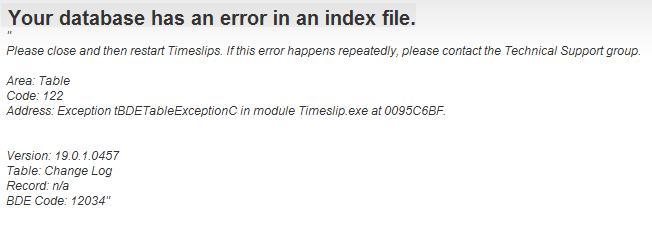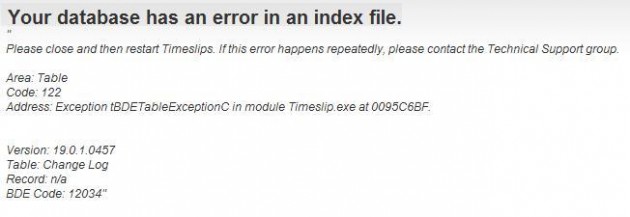
A to Z Tips from TSR: “E” is for Errors and What They Mean
Your database has an error in an index file.
What does it mean? Is my data lost?
The key to understanding error messages is to read the description. The above error indicates that the problem is with the Change Log. The change log tracks changes made to the data and if corrupt, can be easily replaced with a new, empty change log.
STEP 1: BACK UP OR COPY YOUR DATABASE!!!! THEN, RUN DATA VERIFICATION – LOOK FOR ERRORS — Do not check the options to repair errors.
Data Verification is run (by click FILE … DATA VERIFICATION). The report that prints when data verification completes has very valuable information in pinpointing the cause of the error.
There are basically 3 types of errors that will appear that are easy to identify:
- Validation Error – Means a field in the database is corrupt. This will happen if, for example, a client’s bill was being finalized when Timeslips closed and the client’s “Bill Stage” is stuck in a state between “approved” and “proof”. This field can be corrected with no other database affect.
- Integrity Error – The structure of the database table is corrupt. This sounds much worse than it usually is. There is a utility to rebuild the structure leaving the data intact. It requires expertise in Timeslips data repair, but it is a successful utility.
- Index Error – The links between the various tables sometimes need to be reset. By re-indexing the database, it is often possible to repair the index error.
Another error that is common is “System Error, Code 2”. This particular error is more difficult to diagnose. It sometimes has more to do with the environment than it does Timeslips. Common causes include too many temp files (stored in the computer’s temp folder), a corrupt BDE (Borland Database Engine), or a corrupt statement or bill layout.
Database errors can be resolved. Don’t panic … read the messages, run data verification and contact an experienced Timeslips consultant such as TSR Consulting Services for assistance.


